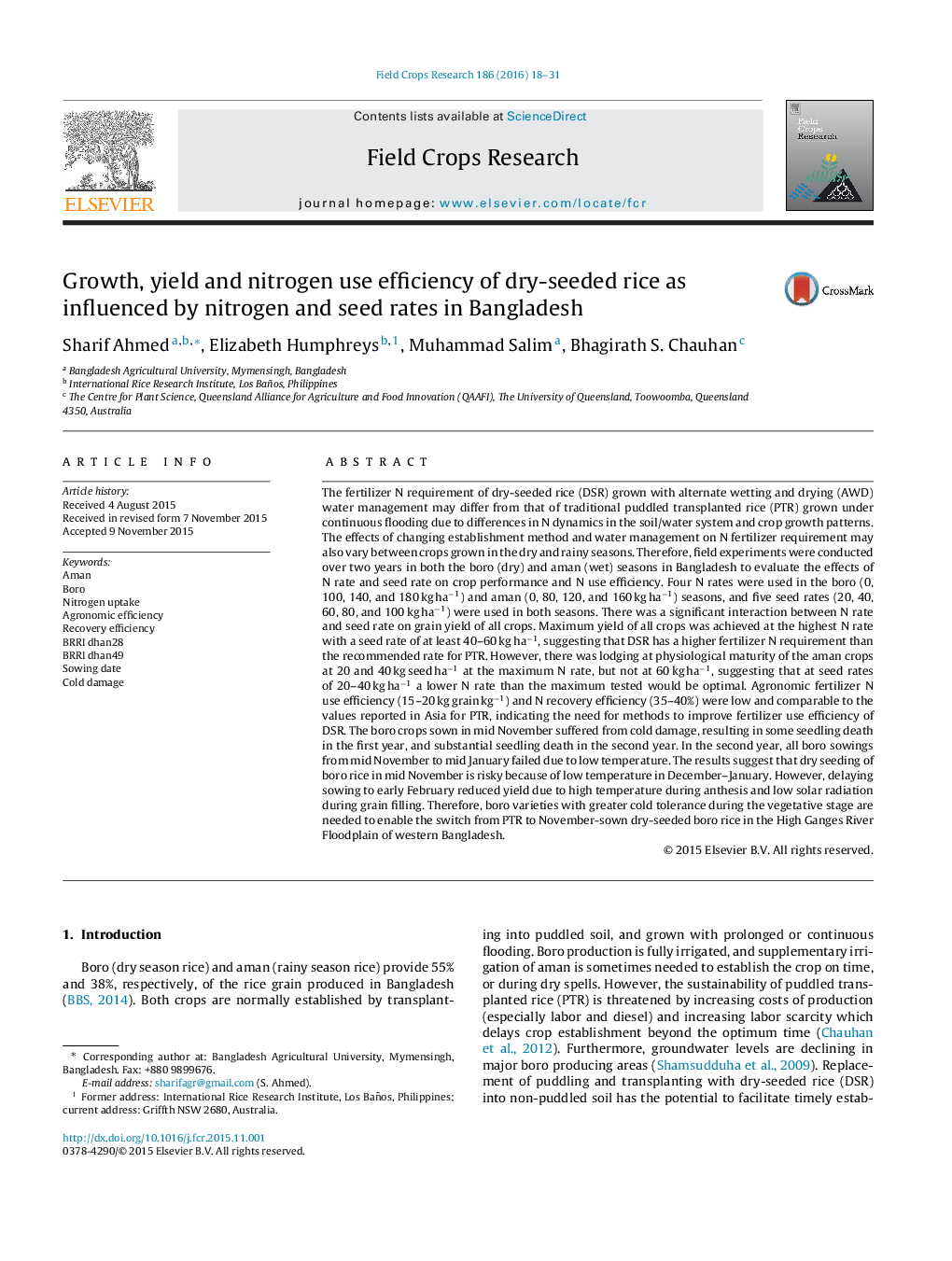| کد مقاله | کد نشریه | سال انتشار | مقاله انگلیسی | نسخه تمام متن |
|---|---|---|---|---|
| 6374742 | 1624677 | 2016 | 14 صفحه PDF | دانلود رایگان |
عنوان انگلیسی مقاله ISI
Growth, yield and nitrogen use efficiency of dry-seeded rice as influenced by nitrogen and seed rates in Bangladesh
ترجمه فارسی عنوان
راندمان رشد، عملکرد و مصرف نیتروژن برنج دانه خشک دانه تحت تأثیر میزان نیتروژن و بذر در بنگلادش
دانلود مقاله + سفارش ترجمه
دانلود مقاله ISI انگلیسی
رایگان برای ایرانیان
کلمات کلیدی
موضوعات مرتبط
علوم زیستی و بیوفناوری
علوم کشاورزی و بیولوژیک
علوم زراعت و اصلاح نباتات
چکیده انگلیسی
The fertilizer N requirement of dry-seeded rice (DSR) grown with alternate wetting and drying (AWD) water management may differ from that of traditional puddled transplanted rice (PTR) grown under continuous flooding due to differences in N dynamics in the soil/water system and crop growth patterns. The effects of changing establishment method and water management on N fertilizer requirement may also vary between crops grown in the dry and rainy seasons. Therefore, field experiments were conducted over two years in both the boro (dry) and aman (wet) seasons in Bangladesh to evaluate the effects of N rate and seed rate on crop performance and N use efficiency. Four N rates were used in the boro (0, 100, 140, and 180 kg haâ1) and aman (0, 80, 120, and 160 kg haâ1) seasons, and five seed rates (20, 40, 60, 80, and 100 kg haâ1) were used in both seasons. There was a significant interaction between N rate and seed rate on grain yield of all crops. Maximum yield of all crops was achieved at the highest N rate with a seed rate of at least 40-60 kg haâ1, suggesting that DSR has a higher fertilizer N requirement than the recommended rate for PTR. However, there was lodging at physiological maturity of the aman crops at 20 and 40 kg seed haâ1 at the maximum N rate, but not at 60 kg haâ1, suggesting that at seed rates of 20-40 kg haâ1 a lower N rate than the maximum tested would be optimal. Agronomic fertilizer N use efficiency (15-20 kg grain kgâ1) and N recovery efficiency (35-40%) were low and comparable to the values reported in Asia for PTR, indicating the need for methods to improve fertilizer use efficiency of DSR. The boro crops sown in mid November suffered from cold damage, resulting in some seedling death in the first year, and substantial seedling death in the second year. In the second year, all boro sowings from mid November to mid January failed due to low temperature. The results suggest that dry seeding of boro rice in mid November is risky because of low temperature in December-January. However, delaying sowing to early February reduced yield due to high temperature during anthesis and low solar radiation during grain filling. Therefore, boro varieties with greater cold tolerance during the vegetative stage are needed to enable the switch from PTR to November-sown dry-seeded boro rice in the High Ganges River Floodplain of western Bangladesh.
ناشر
Database: Elsevier - ScienceDirect (ساینس دایرکت)
Journal: Field Crops Research - Volume 186, 1 February 2016, Pages 18-31
Journal: Field Crops Research - Volume 186, 1 February 2016, Pages 18-31
نویسندگان
Sharif Ahmed, Elizabeth Humphreys, Muhammad Salim, Bhagirath S. Chauhan,
